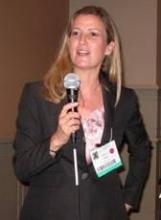PHILADELPHIA – The practice of psychotherapy by psychiatrists dropped by 20 percentage points from 2002 to 2010, in large part because of low reimbursement levels and the inability of many patients to afford psychotherapy sessions out of pocket, based on results from a 2010 survey completed by 394 practicing psychiatrists.
The survey results did not address the extent to which the psychotherapy that psychiatrists no longer provide has been replaced by sessions with other types of psychotherapy providers, Joyce C. West, Ph.D., said at the annual meeting of the American Psychiatric Association. "The trend is for psychiatrists to be team leaders" in caring for psychiatric patients, and for psychiatrists to "make referrals for psychotherapy to other team members," said Dr. West, director of policy research at the American Psychiatric Institute for Research and Education in Arlington, Va.
In contrast, during the same period, psychiatrists embraced pharmacotherapy more tightly, with the use of drug therapy rising to 89% of responding psychiatrists in 2010, up from 81% in 2002 and from 54% in 1988.
Growth in the availability of psychotherapy from nonpsychiatrists helped keep psychotherapy available. "There clearly is a strong evidence base for [the efficacy of] psychotherapy, and patients with resources [to pay for it themselves] are more likely to want psychotherapy," she noted.
The survey results and other recent psychotherapy assessments document a shift in who delivers psychotherapy. "The percentage of the population receiving psychotherapy in a year has not significantly lowered," at 3.18% of the U.S. population in 2007, essentially unchanged from the 3.37% rate in 1998. "However, there was a decline in psychiatrists providing psychotherapy; more patients of psychiatrists received medications, rising from 44% in 2002 to 57% in 2010. It appears that psychotherapy increasingly shifted away from psychiatrists, while other professions provided it," said Dr. John Christopher Perry, a coinvestigator with Dr. West on the survey, and a professor of psychiatry at McGill University in Montreal.
Is it okay if a steady number of patients has access to psychotherapy, but that it increasingly comes from nonpsychiatrists? "Psychotherapy is a core discipline in psychiatry, but it is shared with other professions. Understanding the mind and body, and understanding how intervening with one affects the other is an approach that is unique to psychiatry.
"If psychiatrists shift to mostly being diagnosticians and prescribers, we will lose this and become less knowledgeable about understanding and helping people. When a psychiatrist only manages medications and someone else provides psychotherapy, it limits the view of a patient’s symptoms, and may lead to overprescribing. When the psychiatrist is also the therapist, there is better opportunity to deal with life stress, coping, and distress without relying primarily or solely on prescribing," said Dr. Perry, who is also director of psychotherapy research at Jewish General Hospital in Montreal.
To examine how psychiatrists used psychotherapy in 2010, Dr. West, Dr. Perry, and their associates sent a 36-item questionnaire on the subject to a random sample of 3,000 members of the American Psychiatric Association, excluding medical students and residents. The researchers received completed surveys from 394 practicing psychiatrists. The respondents averaged 54 years old, two-thirds were men, 83% were white, and half were in private practice. Each psychiatrist saw an average of 42 patients in a typical week.
When asked how they treated patients during their most recent typical week, 48% said that they used psychotherapy and 89% said that they used pharmacotherapy – either in combination or as monotherapy – in an analysis that weighted responses based on the number of patients each psychiatrist treated. For psychotherapy, the 48% prevalence of use compared with 68% in a 2002 survey and 72% in a 1988 survey. The drug therapy rate of 89% in 2010 compared with 81% in 2002 and 54% in 1988.
When asked what barriers they encountered when performing psychotherapy, 80% of responding psychiatrists cited financial barriers, and 72% noted administrative barriers. Financial barriers included an inability of patients to afford psychotherapy sessions themselves, and low reimbursement rates from third-party payers. Administrative barriers included dealing with insurance companies and writing treatment notes.
Half the responding psychiatrists also cited pressure to treat psychotherapy patients in shorter sessions and with fewer sessions, and 48% reported pressure to spend more time focused on diagnosis and on pharmacologic consultations. Just over half the respondents said their practice of psychotherapy would increase if the reimbursement level approached that for pharmacotherapy.
Responding psychiatrists found pharmacotherapy somewhat more effective, with 87% saying they were satisfied with the efficacy or helpfulness of pharmacotherapy, compared with 76% who had the same assessment of psychotherapy.



